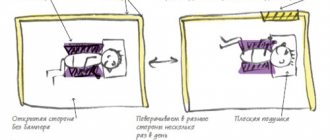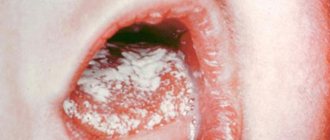After the birth of a child, many parents experience difficulties with their children's sleep. Often the baby cries, is capricious, and cannot calm down and fall asleep at the right time. In such a situation, experts recommend using white noise for newborns, which will help quickly solve the pressing problem without much effort.
White noise helps your baby sleep peacefully.
What is white noise
Experts define white noise as a constant monotonous sound stream that drowns out surrounding household noises, has a relaxing effect on the brain and nervous system and promotes rapid sleep. It contains frequencies of the entire audio range, from 20 to 20,000 Hz. The phenomenon was named by analogy with the color white, which combines all the shades of the palette.
This uniform background is often used by parents of small children when they cry, are capricious, or cannot fall asleep during the day or night. Thanks to the constant, uninformative hum, babies quickly calm down and fall asleep within a few minutes.
Origin of the idea
Scientists and doctors have proven that a small child has difficulty falling asleep both in a noisy room and in complete silence. While in the womb, he constantly hears background sounds (breathing, blood flow, heartbeat), and after birth he needs to get used to a new, often irritating, unusual sound environment.
Therefore, doctors recommend using monotonous noises, hearing which the baby quickly calms down and falls asleep.
American scientists invented background sound generators for relaxation back in the middle of the last century. They were used in hospitals to help patients with sleep disorders fall asleep. Gradually, such devices began to be used to normalize sleep functions in young children.
The effect of white noise on humans.
Sound torture, which was used in Ancient China, was considered the most cruel. And being in a chamber called a “music box” split the most persistent intelligence officers. It's not all about the sound, but its volume, frequency and intermittency.
- The volume or intensity of sound in densely populated cities sometimes exceeds the noise of production. And often becomes the cause of chronic fatigue and stress.
- High-frequency sounds are very poorly perceived by our brain and cause mental disorder.
- Intermittent, but not rhythmic noises constantly keep the brain in tense anticipation: when will the next note be heard.
Classic white noise is perceived as a cross between annoying sounds and absolute silence. But it affects different people differently. It calms some people, irritates others. It's not about the noise itself, but about our psyche, the work of internal organs, electrophysiological signals of skeletal muscles, and the interaction of neurons (transmitters of sound stimulation). When external and internal vibrations do not coincide too much, balance is lost and the desired relaxation is replaced by irritation.
Benefits of white noise for newborns
Doctors believe that background sounds are beneficial for young children for several reasons:
- They have the ability to mask extraneous noise. This is especially useful in situations where babies are in rooms where it is impossible to provide the level of silence necessary for a peaceful sleep (people talking, doors slamming, dogs barking). A monotonous hum drowns out and makes such extraneous sounds indistinguishable to the brain.
- Muffled background noises have a relaxing effect on the nervous system. They remind the baby of the sounds he heard while in the womb, so they have a calming effect on him in the first months of life.
- They improve the quality of sleep and make it deeper. The newborn does not wake up every half hour, which parents often complain about. This solves the problem of sleep fragmentation: it becomes longer, and the baby gets better sleep.
Only after a good, full sleep will the baby wake up rested and cheerful.
What is white and pink noise for a newborn and why is it needed?
The “white” noise technique is based on the laws of physics and the observations of somnologists and pediatricians.
Let's start with physics. Noise can be any sound or set of sounds, usually of varying strength and frequency. By and large, noise is an integral part of our lives.
By analogy with the color spectrum, colors were assigned to some noises (see photo).
Noise spectrum
How to explain the concept of “white noise” in human language? Imagine a huge orchestra. With a wave of the conductor's baton, the musicians begin to play. However, each of them plays only one, his own note. As a result, the listener simultaneously hears all the sounds that his ear can distinguish. This sound vinaigrette is “white” noise (WH).
Do we hear “white” noise in everyday life? Yes, all the time.
Thus, natural “white” noise includes
- sounds we hear when it rains
- rustle of leaves in the wind,
- sound of the sea surf
- noise of blood in the veins, etc.
In everyday life, we also quite often encounter “white” noise when we hear:
- the sound of a working vacuum cleaner, fan or hair dryer,
- the sound of a TV or radio receiver not tuned to the wave,
- the sound of water flowing from a shower head, etc.
How does white noise work? The fact is that most of our organs, incl. hearing is active during our sleep. Accordingly, as soon as our hearing aid detects a change in the sound background, and the brain converts these changes into sound, consciousness goes into “wakefulness” mode.
We recommend reading: How to quickly put a child to sleep in 5 minutes: 12 effective methods, 10 rules from Komarovsky
In this case, the SB smoothes out the resulting sound changes, absorbing any vibrational movements. Accordingly, due to this, the quality of sleep improves. In fact, BS is an ideal camouflage agent. Other effects of BS on the human psyche are discussed in the next part of the review.
“Pink” noise (RM) sounds softer compared to BS. Consists of a mix of high and low frequency sounds. In addition, RS is distinguished by a certain periodicity - every octave the sound seems to fade.
- Natural “pink” noise includes the sound of a heartbeat - one of the first basic sounds that a baby hears in the womb.
- For artificially created RS - the sound of a flying helicopter, etc.
If BS causes a persistent feeling of rejection in you or your baby, try using RS.
Pediatricians and somnologists recommend using white/pink noise if:
- the baby will have to fall asleep in a new place;
- the baby is overexcited and cannot cope with his own emotions (you must agree, demanding control over emotions from a newborn baby is simply stupid);
- if new sounds appear in the environment surrounding the baby (for example, the sounds of a hammer drill or a drill behind the wall);
- if the baby has a slight physical ailment;
- if the baby has problems with sleep cycles and wakes up every 20-40 minutes, etc.
Harm and side effects
Although white monotonous noise is beneficial for children and provides a number of benefits for parents, in some cases it is harmful to the child's health. In addition, improper use of this product may lead to unwanted effects.
Hearing impairment
If, when using noise generators, the volume exceeds the 50 dB recommended by doctors, and adults use the device to speed up falling asleep quite often, the child may experience hearing impairment. Moreover, the mother or pediatrician may not immediately notice this.
Therefore, it is important to follow the rules and not exceed the volume set for normal falling asleep.
Delayed speech development
Some mothers worry that their children may experience speech delays if they use noise machines to fall asleep. However, this is not quite true.
Such a pathology, according to experts, can only appear if the child has hearing impairment. He hears poorly and does not recognize words, does not strive to repeat them and link them into meaningful sentences.
Therefore, you should always ensure that the noise level does not exceed the established norm.
addictive
Doctors note that a constant monotonous sound signal in some cases can be addictive.
Therefore, doctors advise mothers not to use such a background at a time when the baby is awake and actively recognizing the world around him and the people nearby.
Gradually, when the child grows up and can calmly fall asleep on his own, noise generators can be abandoned and used only in emergency cases, for example, during illness or during a change of environment when it is difficult to fall asleep.
Interesting facts about the white noise phenomenon
Interestingly, soothing noise is not only white. There are red, blue, violet, cyan, green and pink noises. So, an example of pink is the distant sound of a waterfall. There is also black noise, which is perceived as complete silence.
It is believed that white noise for newborns reduces the likelihood of sudden infant death during sleep. However, this is not entirely true, because... These studies have not found practical confirmation. At the same time, there are studies confirming the effectiveness of white noise for somnambulism. Thanks to this sedative, the likelihood of children walking in their sleep is reduced.
Does white noise help with intestinal colic?
Quite often, parents are given a lot of anxiety by intestinal colic, which affects almost all newborns. Nevertheless, this is a normal physiological process characteristic of a young body.
The digestive system gradually adapts to new foods, so the child's sleep may become interrupted and restless. Without enough sleep, the baby begins to be even more capricious.
One effective way to help your newborn establish a sleep routine is to use background noise. It helps you relax and not react so sharply to abdominal discomfort.
However, you should consult your pediatrician if the baby's condition does not improve within a few days.
How does white and pink noise affect a child’s psyche: benefits and harms
White noise: benefits and harms
Important: the reaction to noise of each individual is unpredictable! Constant long-term exposure to BS can cause increased blood pressure and headaches. In addition, constant exposure to noise above 50 dB can significantly impair hearing.
So, noise, like any other noise, causes stress.
To cope with a stressful situation and restore homeostasis, the body begins to actively produce the hormone cortisol.
The release of cortisol into the blood affects the prefrontal cortex of the brain, which is responsible, among other things, for deep sleep.
In addition, the monotonous BS is familiar to the baby from the sound of blood movement, which the baby heard while in his cozy “house”.
Pink noise is also as close as possible to the sounds that a baby hears in the womb:
- heart beat,
- sounds accompanying bowel movements, etc.
Accordingly, what is comfortable for a baby is not deaf silence, but an environment filled with sounds. But the sounds should be extremely familiar, “native”. And then they will be a powerful tool that triggers the “self-soothing” mode.
How to use white noise correctly
To calm a newborn when he cries or is fussy, the volume of the noise should first be made higher than the baby's cry. This is necessary so that he pays attention to new sounds and begins to listen. Then the volume must be turned down.
Scientists have experimentally found that white background noise is most useful only when it does not exceed 50 dB. To measure this indicator, you can install a simple noise meter on your phone and use it if necessary.
Volume above 85 dB negatively affects the nervous system and can lead to overexcitation, stress and sleep disturbances.
People cannot perceive sound below 50 dB, and the use of devices becomes useless. You need to check the background level directly next to the ear of a sleeping child.
Household appliances that are used as sources of hum should be located no closer than 1.5 m from the crib so that they do not negatively affect the hearing organs.
The noise level for an infant should not exceed 50 dB.
Benefits and harms
- The white noise method is most effective for children in the first 4 months. This is due to the fact that intrauterine sensations are stored in the baby’s memory. The child remembers the sounds he heard in the mother's womb, white noise calms him and provides psychological comfort.
- An important benefit of white noise is promoting sleep. Healthy sleep has the most beneficial effect on the baby’s nervous system; the baby gets a good night’s sleep, which means that while he’s awake, the baby will feel great, won’t be capricious, and will be happy to communicate with his mother and explore the world around him.
- White noise will give mom free time. Instead of spending hours rocking the baby to sleep and running to the cradle at every sound coming from the street, she can calmly take care of herself, other children or household chores. After all, it takes less time to lull a baby to sleep, and his sleep lasts longer. And you don’t need to constantly monitor the baby while he sleeps, hoping to notice the period of awakening in time and try to rock the baby to sleep again.
- This method is completely harmless. The sounds that make up white noise are within a range that is comfortable for humans. White noise does not affect subconscious processes, the mental and physiological development of the child, and cannot cause hearing impairment.
- The method is not addictive (research has proven this). The baby will grow and develop and, over time, will begin to control his own sleep, and the need for an additional acoustic background will simply disappear.
This is interesting! There is a theory that using white noise while a baby sleeps reduces the incidence of sudden infant death syndrome (SIDS). This is a very controversial statement, since a study by foreign scientists using a fan in a child’s room was aimed at testing the theory of the influence of carbon dioxide accumulation on the breathing of babies. The fan was supposed to accelerate it. And excessive concentrations of carbon dioxide are one of the possible causes of SIDS. The results of the experiment say nothing about white noise.
Thanks to more regular sleep due to white noise, children are less prone to somnambulism (sleepwalking).
How to use the method
It is recommended to use white noise only when the baby is sleeping. Depending on the characteristics of the child, you can turn on the background sound only while falling asleep or leave the sounds for the entire sleep period.
If you need to calm a newborn, then noise is used in accordance with certain rules:
- To calm a child when he cries or is naughty, the acoustic background should be louder than the child's crying. This is necessary so that the baby hears the sound and listens. For example, for that same mother’s “shush” to work, it is necessary that the volume of the mother’s voice exceeds the baby’s crying;
- when the baby stops crying, reduce the volume;
- During sleep, the volume should not exceed 50 dB. Louder noise will be harmful to the psyche and hearing;
- the noise source must be at least one meter away from the child.
Parents also need to know that using the method it is possible to calm the baby only if hysterics and whims are caused by nervous tension, fatigue or psychological discomfort. If the child is not healthy, suffers from colic, is sick or hungry, white noise will not help solve the problem.
Today there are even special devices that generate pleasant noise for newborns. They may have a different design from each other, but most have the same basic principle - a fan, the sound of which helps to calm the child. Some devices generate acoustic noise or are simply players for recorded audio files.
White noise machine
The devices are also packaged in various toys that the baby can take to bed and sleep cuddling. Such options are also convenient when traveling; you can take them on trips - the toy will always help calm the child. There are even nursing pillows that have devices built into them that produce a uniform sound. This option is especially good; mommy will be able to do two things at the same time, feed the baby and put him to bed.
White noise toy
White or pink noise - differences
In addition to white noise, pink noise is used to calm newborns. There are very minor differences between these methods.
By the way, there are other colored noises: pink, red, blue, purple, brown and gray.
- Pink noise is “filtered” white noise. All sharp sounds are removed from the range;
- Pink noise is not as diverse. The resulting acoustic range turns out to be poorer and more monotonous, but many believe that it is more gentle and this option is more suitable for infants.
There is no clear research data that would confirm which type of noise had a more effective and beneficial effect on children. Focus on your baby's tastes and use the acoustic range that most favorably affects your baby. Experiment, select different sounds and their combinations, and soon you will understand which acoustic series evokes the most positive emotions in your child, and which noise he will like the most.
I hope you have received all the necessary information and can improve your little daughter's sleep. You can be sure that thanks to white noise, you will have time for both relaxation and household chores.
I also hope that after this you will no longer have problems with lulling your daughter to sleep and you will have free time, during which you will not only have time to cope with all your affairs, but will also be able to pay a little attention to yourself.
Read also: how to put a child to sleep without tears and whims
White noise sources for babies
To get a uniform background sound signal that helps your child quickly calm down and fall asleep, you can use various sources - from household appliances to online resources.
Appliances
The easiest way to get monotonous noise is from technical devices that are found in every home. A fan provides a stable background that promotes restful deep sleep.
In this case, air jets should not fall on the sleeping child, so as not to cause hypothermia. This household appliance can operate for a long time; the main thing is to ensure that it has a special protective mesh to avoid accidental injury.
A powerful hair dryer can create a uniform noise for a short time, but it cannot be used for too long as it heats up quickly and can be damaged. For short-term use, a vacuum cleaner, washing machine or dishwasher, and a special air humidifier are suitable.
Online resources
You can find many resources on the World Wide Web that offer various options for background noise to help children quickly relax and fall asleep. Such sites are in most cases free and available 24 hours a day.
Among the advantages of online programs is the ability to choose both natural noises (rustling leaves, the sound of rain, sea surf, spring drops) and man-made sounds (the hiss of a TV, the rustle of tires, the sounds of household appliances, the sound of flowing water). The main rule for using Internet content is not to exceed the optimal volume of sound entering the speakers.
Special Applications
On specialized websites, you can simply select and download a special application to your phone or computer that generates monotonous sound effects for relaxation.
Most often, in the library of such programs you can find ready-made noises - the rustling of rain or foliage of varying intensity, the sounds of a waterfall, the murmur of a river, etc.
Most often, such applications can be downloaded for free. It is necessary to set the desired volume and place the gadget at some distance from the crib. Convenience also lies in the fact that you can program the phone to turn off the application after a specified time, when the child is fast asleep.
Stuffed Toys
Some manufacturers of children's products produce special toys equipped with the function of generating monotonous noise for falling asleep. Most often, they operate on batteries and are convenient for the baby to place directly in the crib.
However, mothers who have tried this method note that the child may accidentally touch the toy while sleeping and turn off the sound. Therefore, when using such devices, it is necessary to check them periodically. The cost of a soft toy with a built-in monotonous noise generator varies between 2-4 thousand rubles.
White noise toys for children.
Other
Many mothers notice that the child quickly calms down when he hears the sound of running water (in the bathroom or kitchen). Therefore, you can turn on the tap in the kitchen or bathroom for a while (for example, wash dishes, take a shower, wash small items).
Professional decorators often advise installing small decorative fountains powered by electric current in residential premises. They create beautiful lighting and serve as a source of a pleasant monotonous sound of water murmur, which has a calming effect.
In addition, an indoor fountain purifies and humidifies the air in the bedroom, which helps you fall asleep quickly and sleep soundly.
If it is not possible to use any device to generate a monotonous hum, in the warm season you can open the window so that the child can hear the sounds of passing cars.
Disadvantages of Using White Noise for Children
- Some devices that produce white noise may exceed noise limits recommended for infants.
- If you use white noise excessively, your baby may become addicted and have a harder time falling asleep if the device is not at hand.
- Not all babies respond to white noise.
Beware of low-quality devices that produce white noise
Despite its potential benefits, white noise does not always guarantee safe peace and quiet. In 2014, the American Pediatrics Association tested 14 white noise machines that were designed specifically for babies. It turned out that these devices violate the recommended noise levels. When purchasing a device that soothes babies with white noise, consider the quality of production. Devices that are manufactured in China often violate doctors' recommendations for white noise volume levels.
If you play white noise from a computer or phone, then the danger of exceeding the permissible volume of white noise is also high. After all, it is difficult to measure the volume in decibels of white noise produced by a phone.
Babies can become addicted to white noise
Babies who quickly calm down when playing white noise can sometimes become dependent on it, especially if you turn on white noise not only when the baby is falling asleep, but also during the active phase of sleep. If you don't have a white noise machine at hand, it can be inconvenient.
Some children don't like white noise
It is important to understand that white noise does not work for all children. Every baby is different when it comes to sleep needs, so white noise helps many babies, but not all. If you are using white noise, just make sure you choose a quality device to play it on.
What is important to remember
Using background noises when rocking a baby, it is important to distinguish between the baby's whims and restlessness and his crying from hunger. In such a situation, he will not fall asleep even with the monotonous hum on.
Pediatricians advise mothers to closely monitor their fussy babies. When small children want to eat, they not only cry, but also stick out their tongues, smack their lips, and turn their heads in different directions in search of food. If this happens, newborns should first be fed and then put to sleep. Hungry children do not perceive a monochromatic sound background until they are satiated.
Experts' opinion
Anastasia, pediatrician, Volgograd: “I believe that monotonous sound has a beneficial effect on the child’s nervous system, allowing him to abstract from sharp, frightening noises that interfere with falling asleep. For mothers of restless babies, I always recommend putting them to sleep with muffled white noise.”
Ivan, pediatrician, Moscow: “The idea of using monotonous noises is finding increasing response among specialists and parents, but not all children can calm down and fall asleep quickly in such conditions. In addition, I do not recommend using this method for too long - up to a maximum of 6 months. By this time, the child has developed a natural mechanism for falling asleep.”
User reviews
Tatyana, 23 years old, Khabarovsk: “When our child was born, it was impossible to put him to sleep either day or night. Both we and he suffered. A doctor I know recommended white background noise. We tried many options, but best of all our baby falls asleep to the sound of the surf. We downloaded the app to our phone and normalized both the child’s sleep and our own.”
Natalya, 56 years old, Novosibirsk: “Our granddaughter has had problems with sleep since birth. They advised me to buy and install an indoor fountain in the bedroom. In the evening you turn it on, the water gurgles pleasantly. The child listens, calms down, smiles and falls asleep in literally 10 minutes.”
Many parents, having heard about the use of white noise, just shrug their shoulders in bewilderment. Some people know what it is, but don't use it for some reason.
Let's take you through everything in order: what white noise is for sleep, what are the nuances of its use, the benefits and harms of white noise.
White noise is a sound, as you guessed from the name, it consists of different frequencies, they sound at the same volume level and without changes.
In life, you constantly encounter all kinds of white noise and you didn’t even know it. The sound of a hair dryer, vacuum cleaner, the sound of rain or a waterfall, the hum of a working hood in the kitchen - all this is white noise. When a mother puts her baby to sleep, she also makes a sound that is white noise - she hisses evenly.
For an adult, such noise may seem annoying and interfere with sleep, but not for a child.
Why does this happen?
He spent 9 months in his mother’s belly; his hearing organs begin to work around the fifth month of pregnancy. All this time, the baby heard a uniform hum: the beating of his mother’s heart, the work of the digestive and respiratory systems, the sounds of the surrounding world, muffled by his mother’s body.
You may have noticed that in silence a newborn sleeps poorly and restlessly, but when the humidifier or air conditioner is running, sleep improves significantly. This happens because complete silence frightens him; he is not used to it.
When using white noise, you need to follow certain rules. It is better to download a special application on your phone or tablet; the sound volume should not exceed 50 decibels (about the sound of water from a tap), and the source of white noise is located at a distance of at least 1 m from the baby’s head.
Pros of using white noise:
- Helps you fall asleep faster.
- Calms the baby.
- Improves sleep.
- It can act as an additional association for falling asleep, helps to change sleep cycles independently, without the help of parents.
- Masks extraneous sounds.
- Helps survive colic.
The disadvantages of white noise include the effect on the baby’s central nervous system and hearing. We want to reassure you that if you follow the safety rules that we wrote about above, there will be no harm from white noise.
Separately, I would like to say about special toys that have been gaining popularity lately. They play several variations of white noise and only work when the baby moves. In order to prevent sudden infant death syndrome, it is not recommended to have unnecessary things, including toys, in the crib during the first six months of life. In addition, the toy stops when the child falls asleep and turns on again if he starts tossing and turning. You need to understand that the baby can move in his sleep and the sudden inclusion of white noise in silence will wake him up. And, of course, we should not forget that such a toy will not meet the safety criteria; it lies close to the child, and not a meter away from him.
It is important to understand that white noise is not a magic pill that will get rid of sleep problems. This is an assistant that will only work in conjunction with all other conditions.
Author: Tatyana Kremneva.











